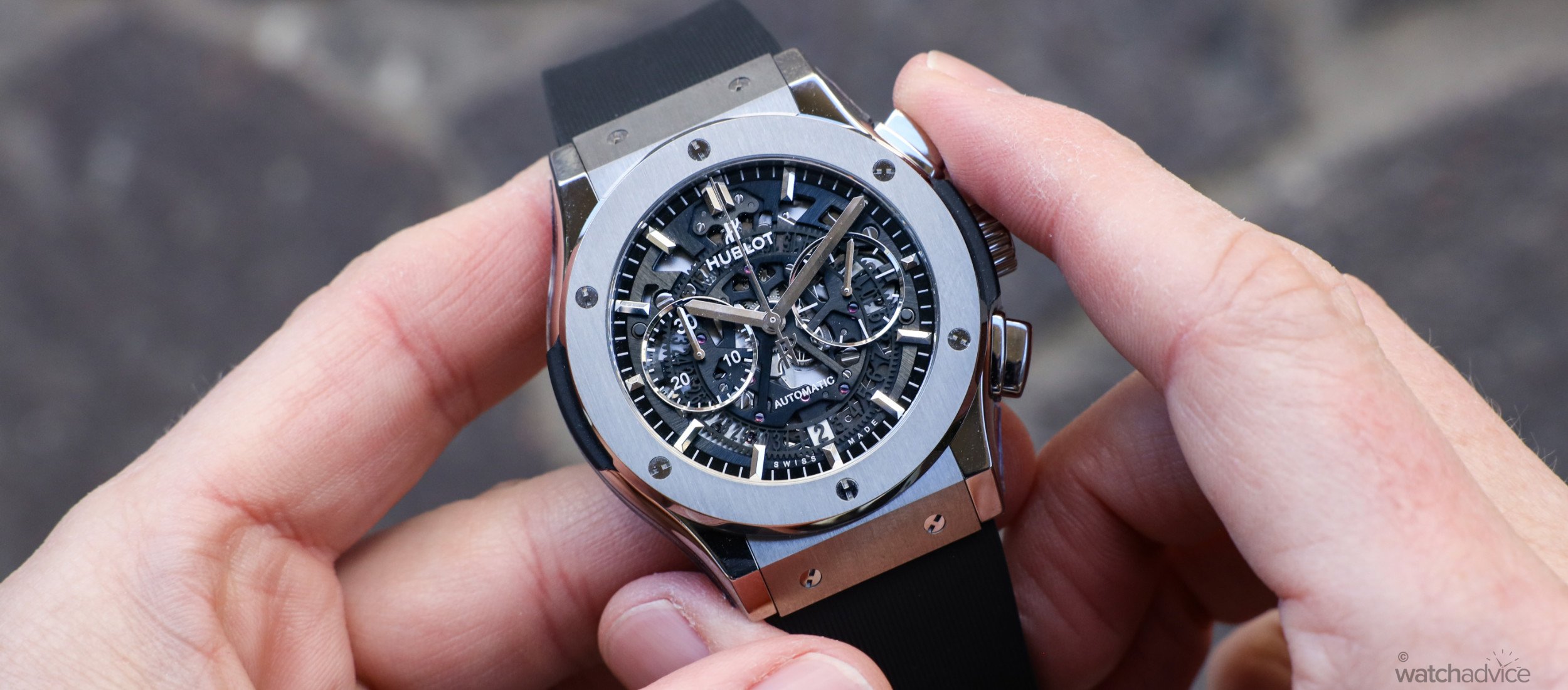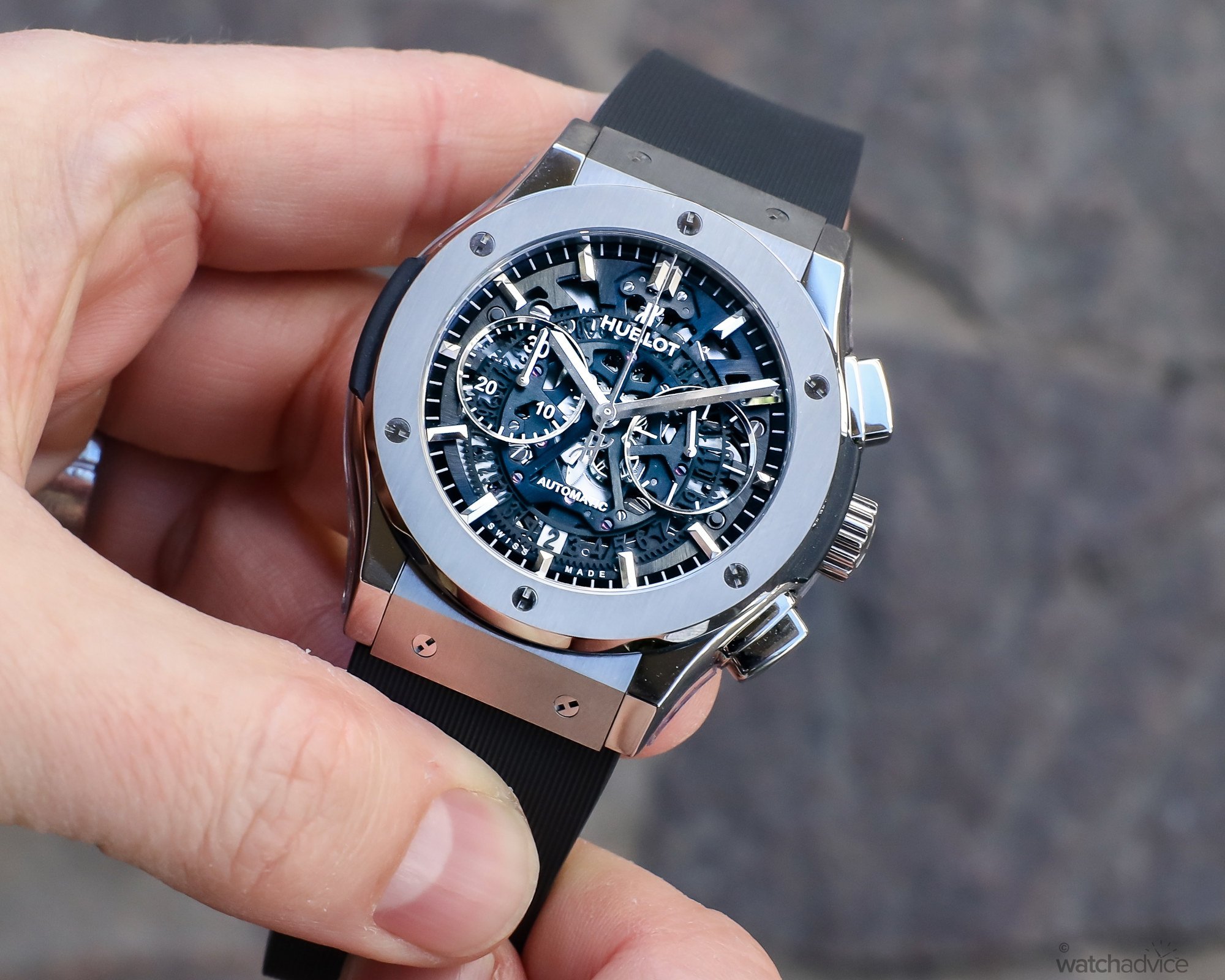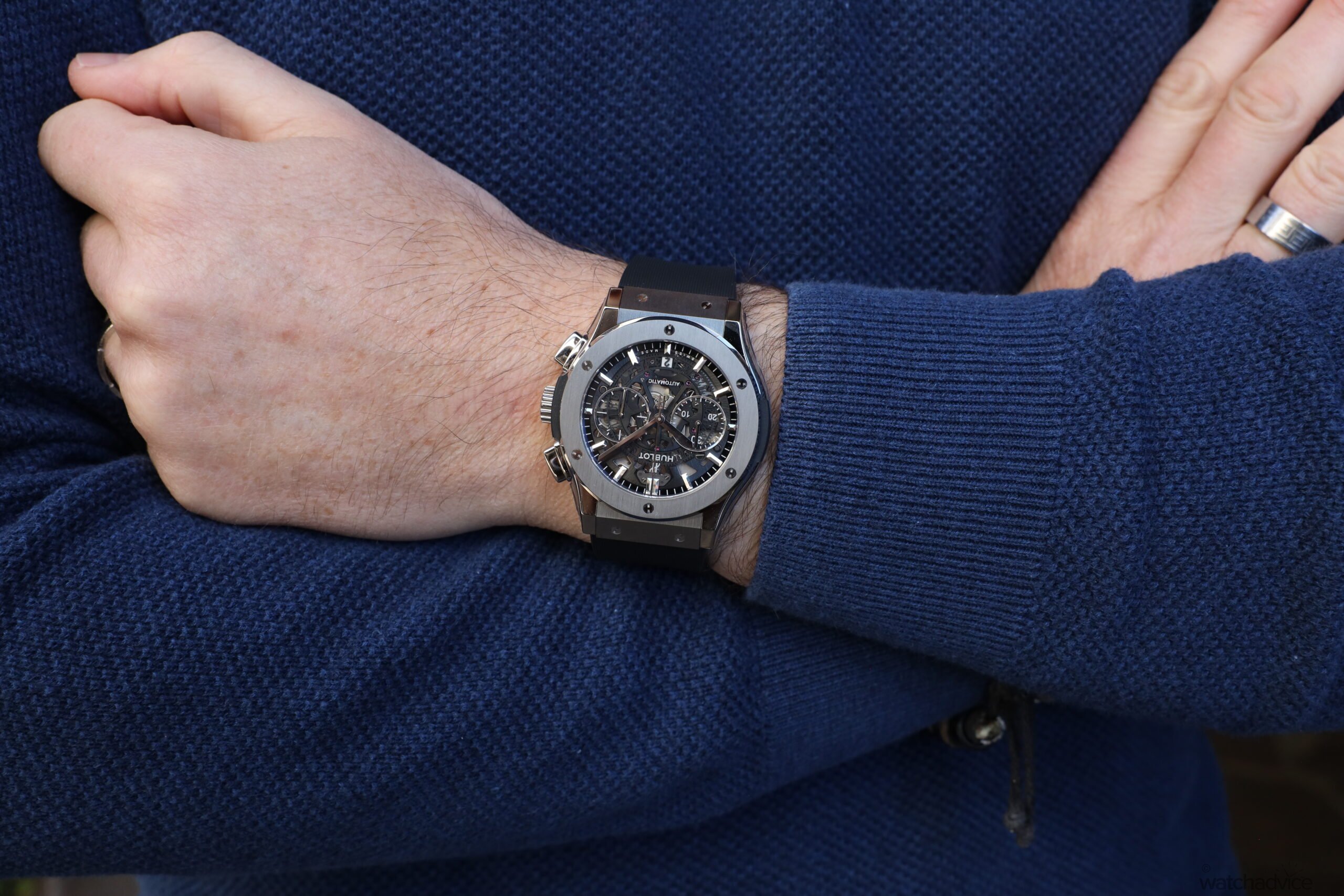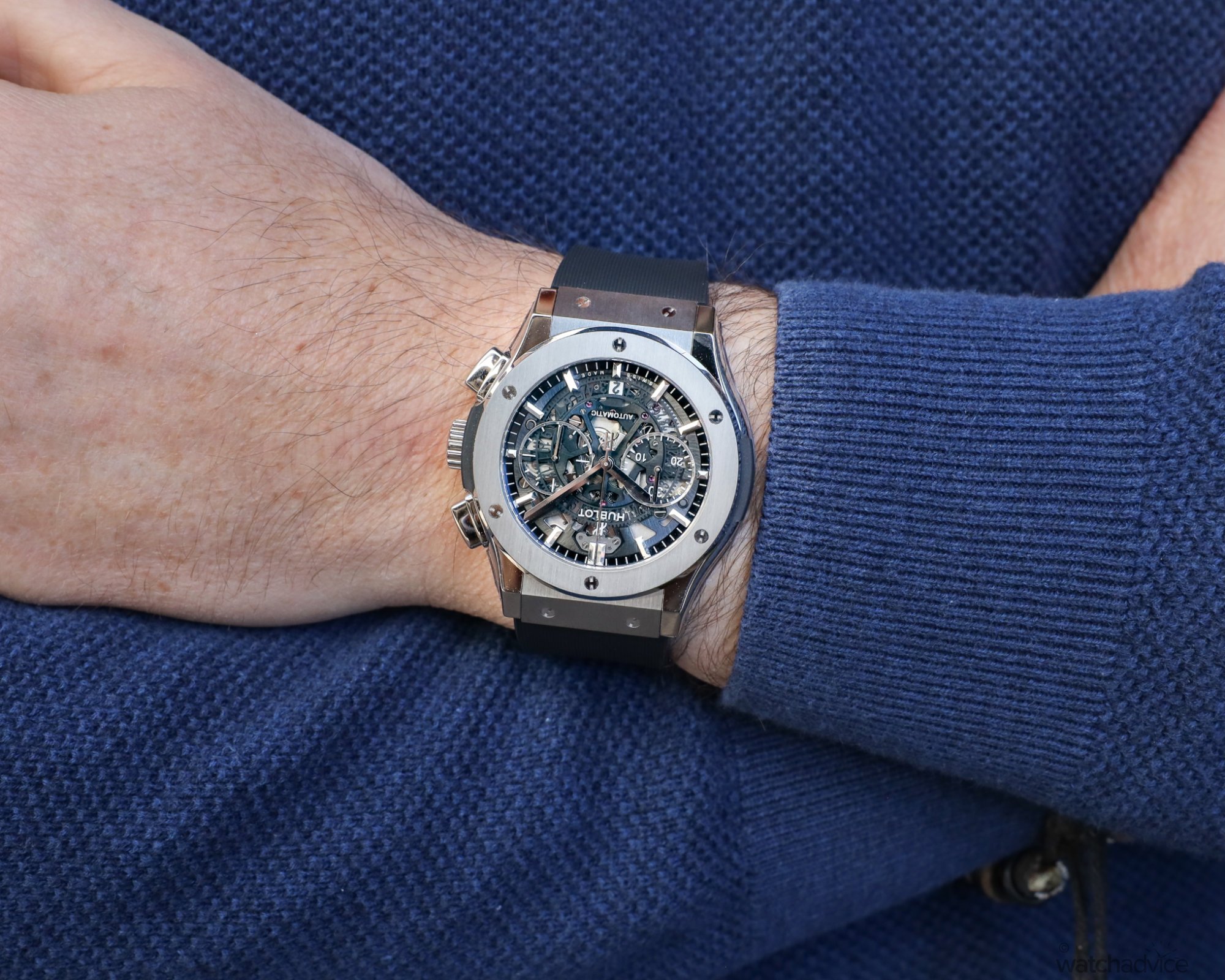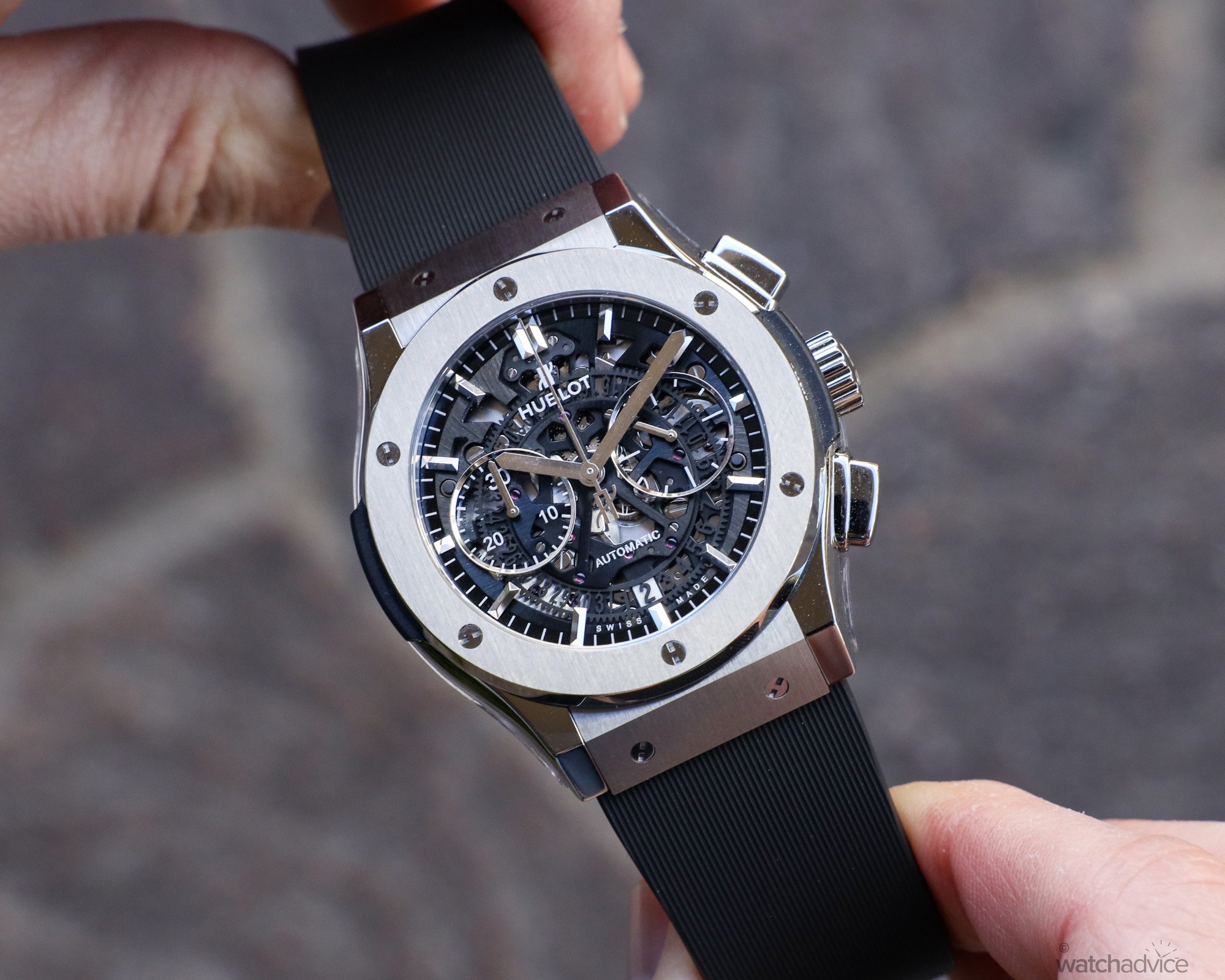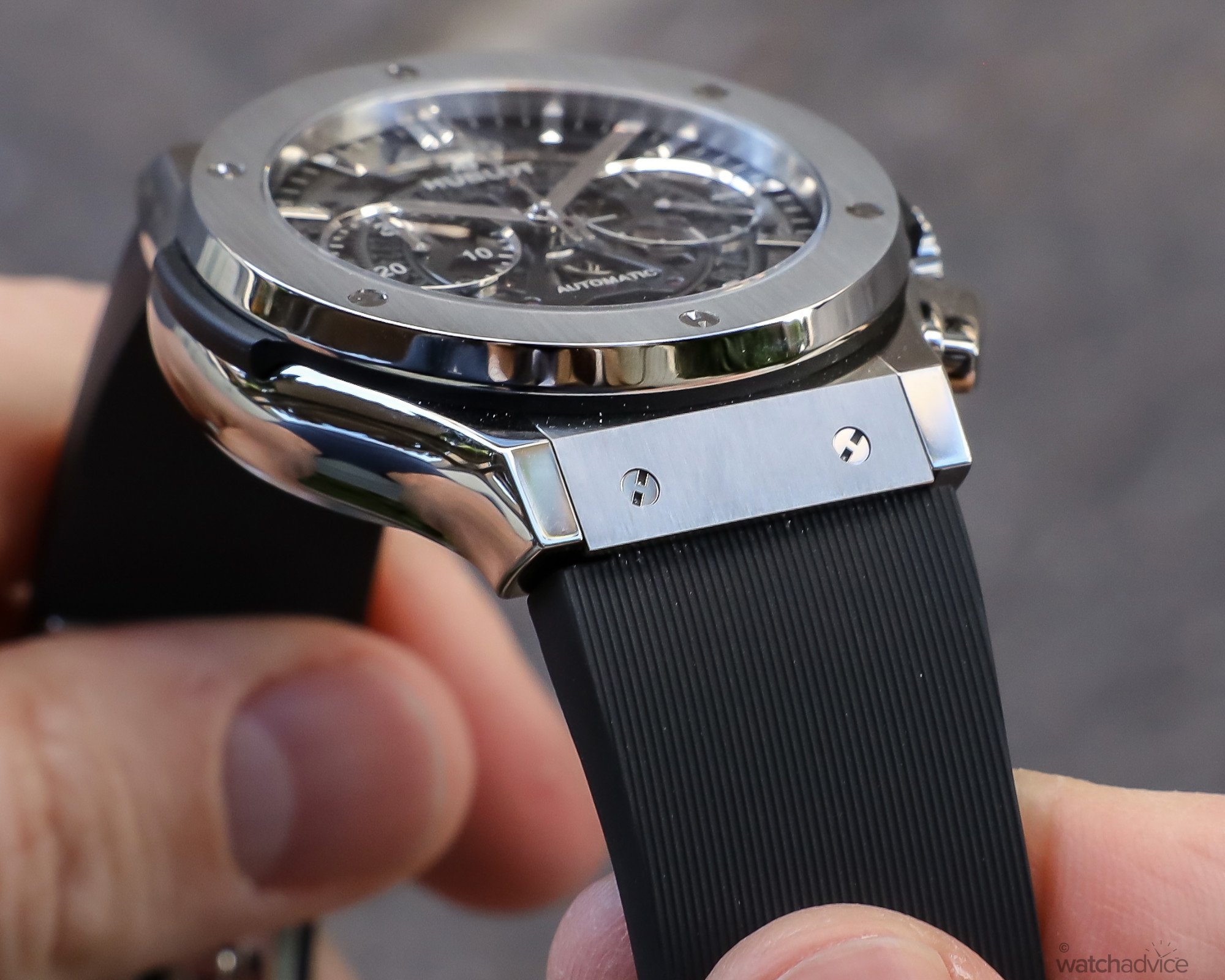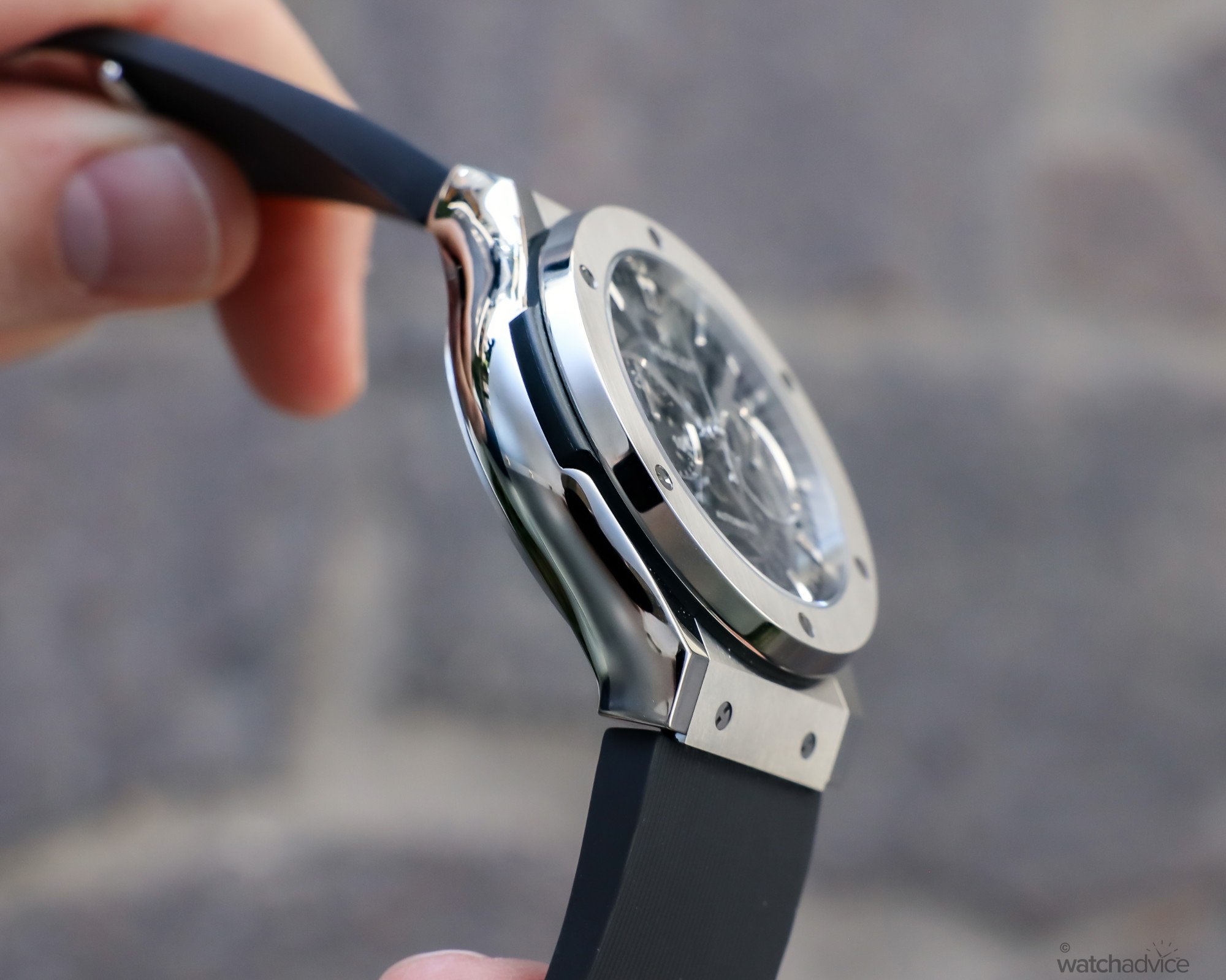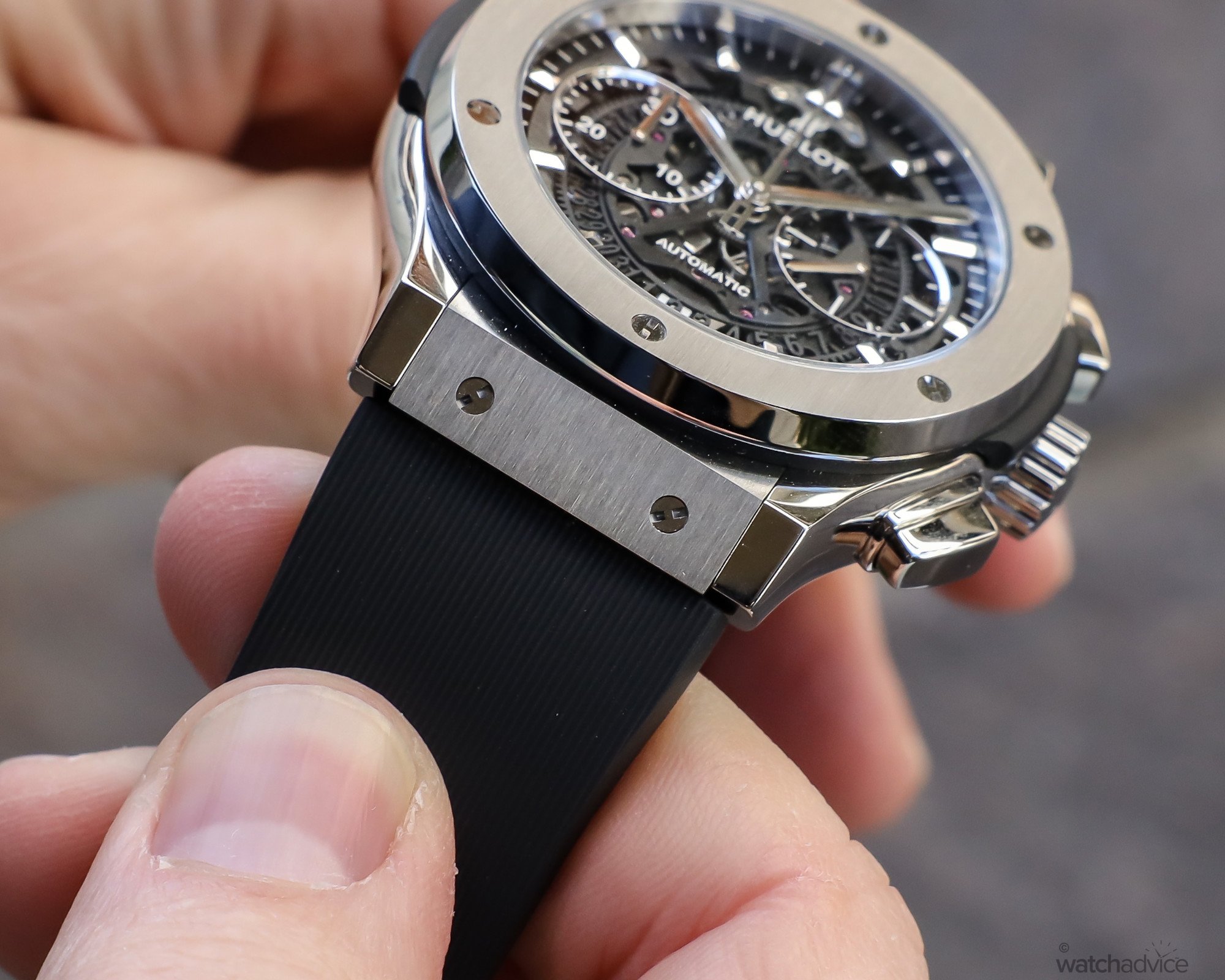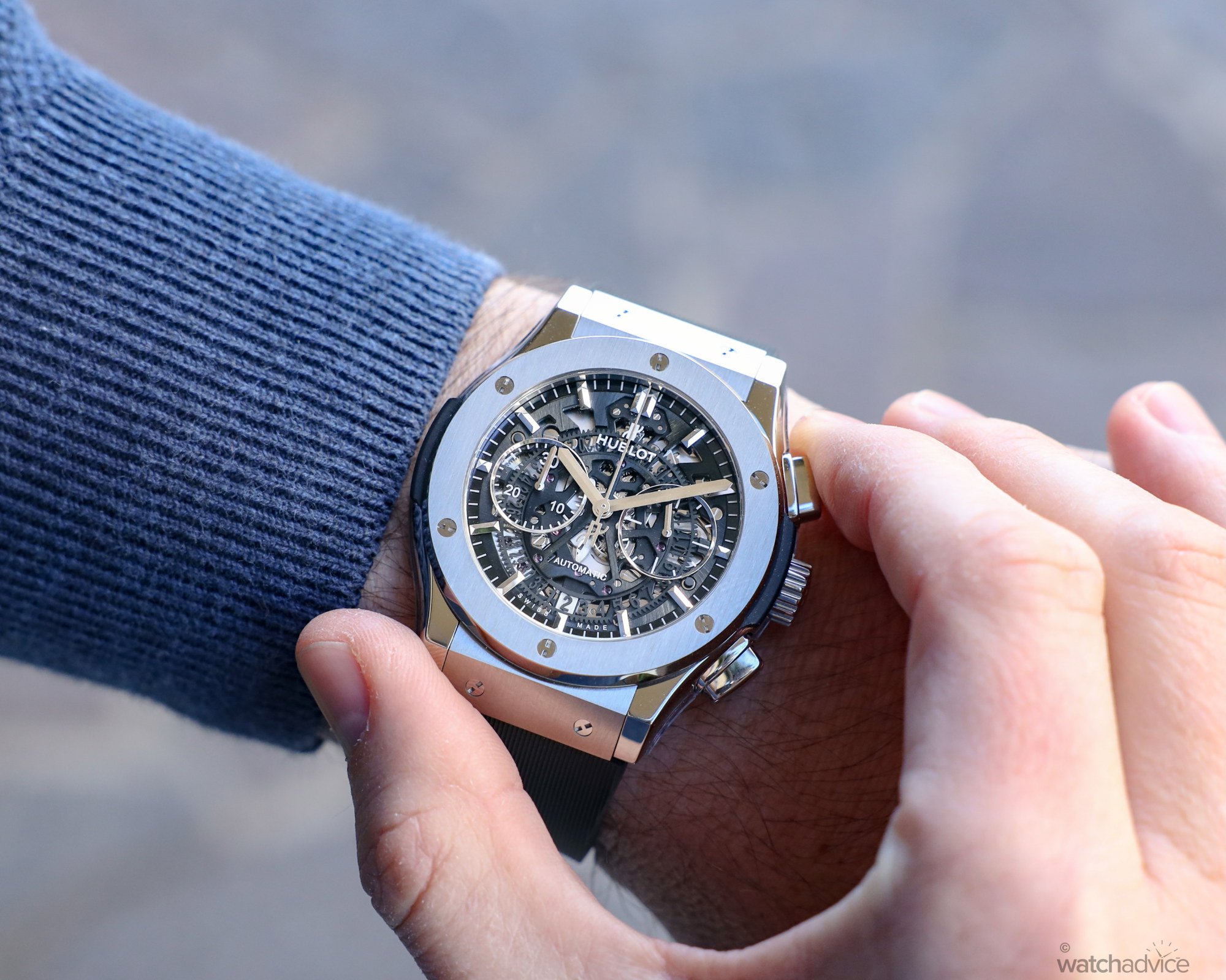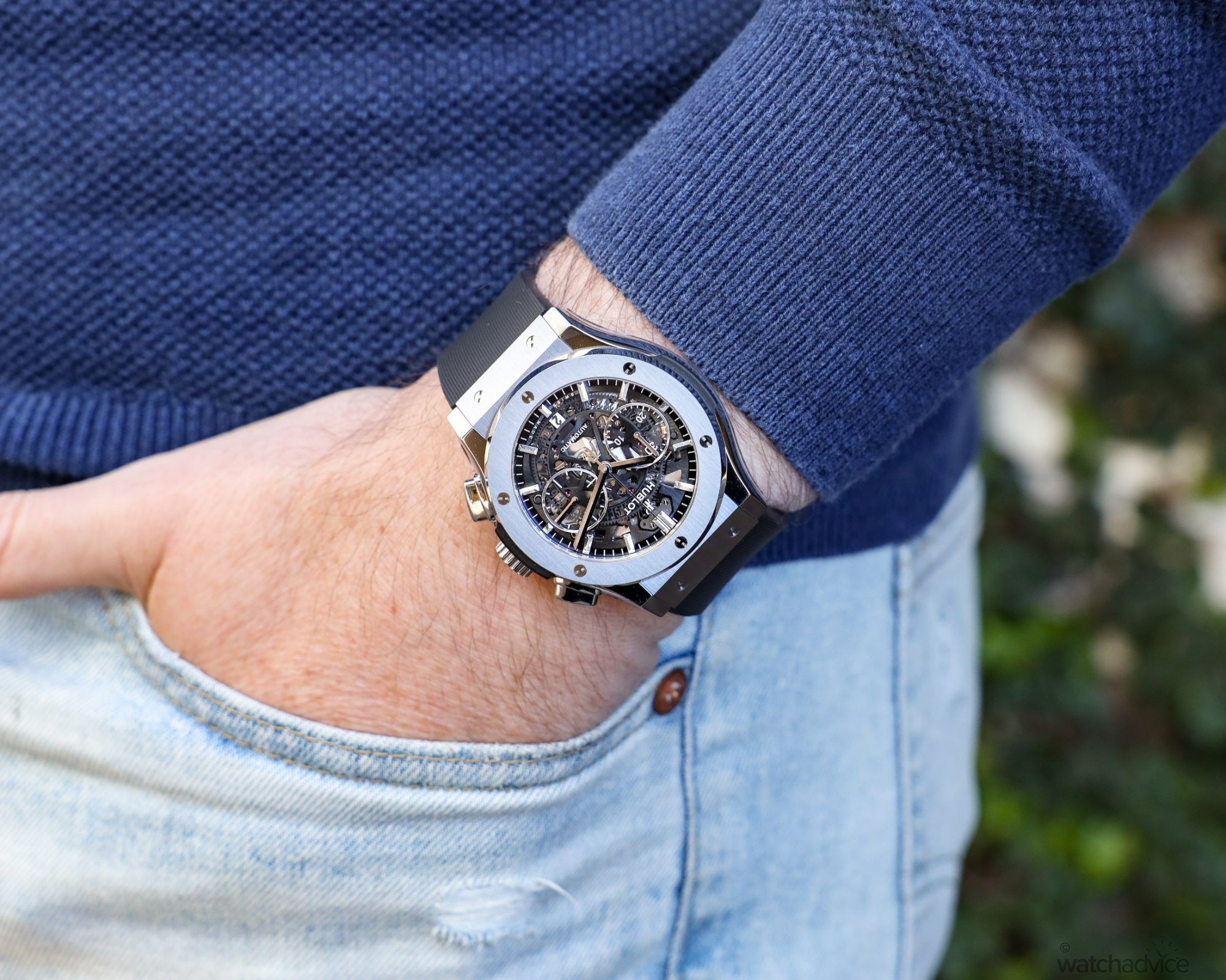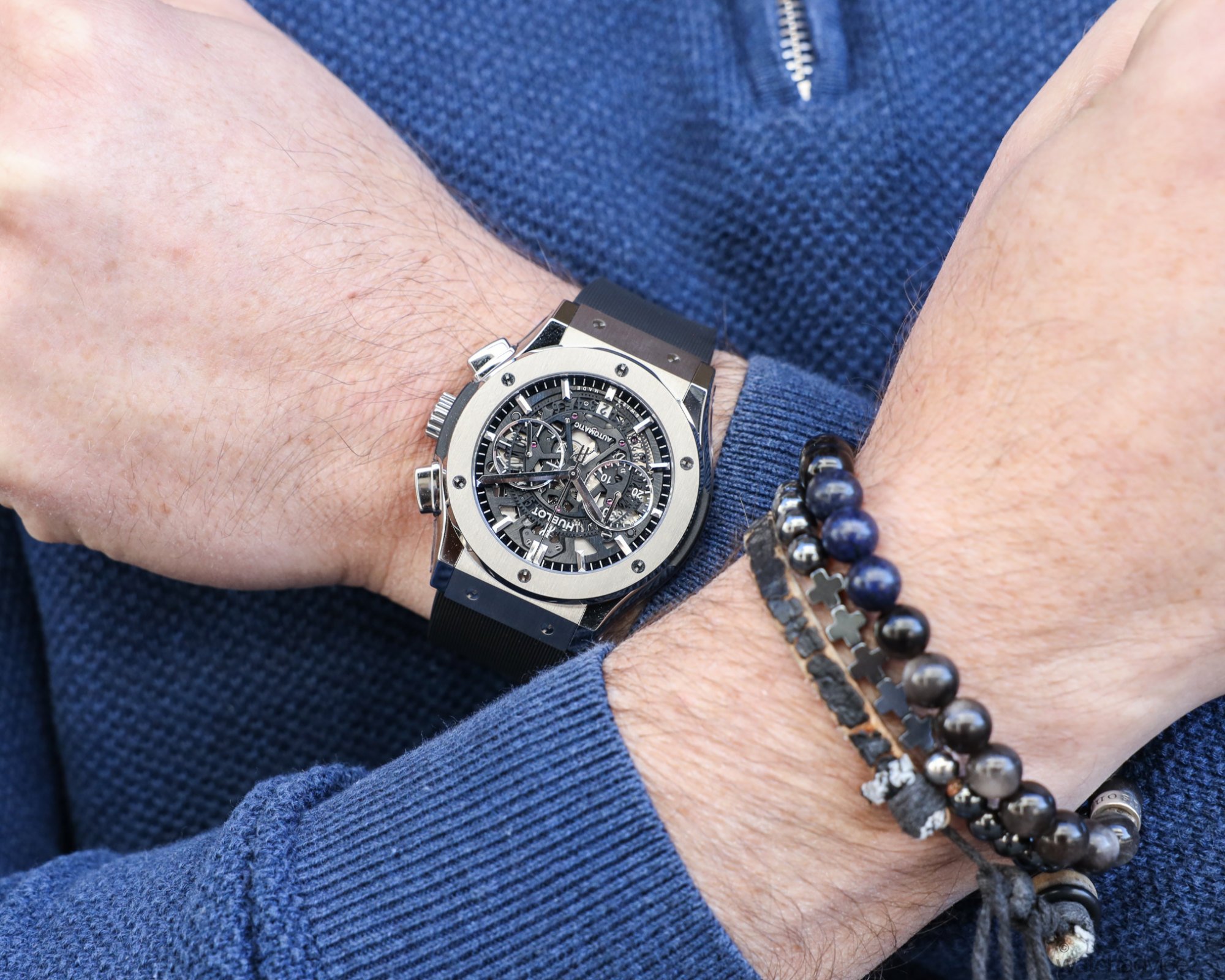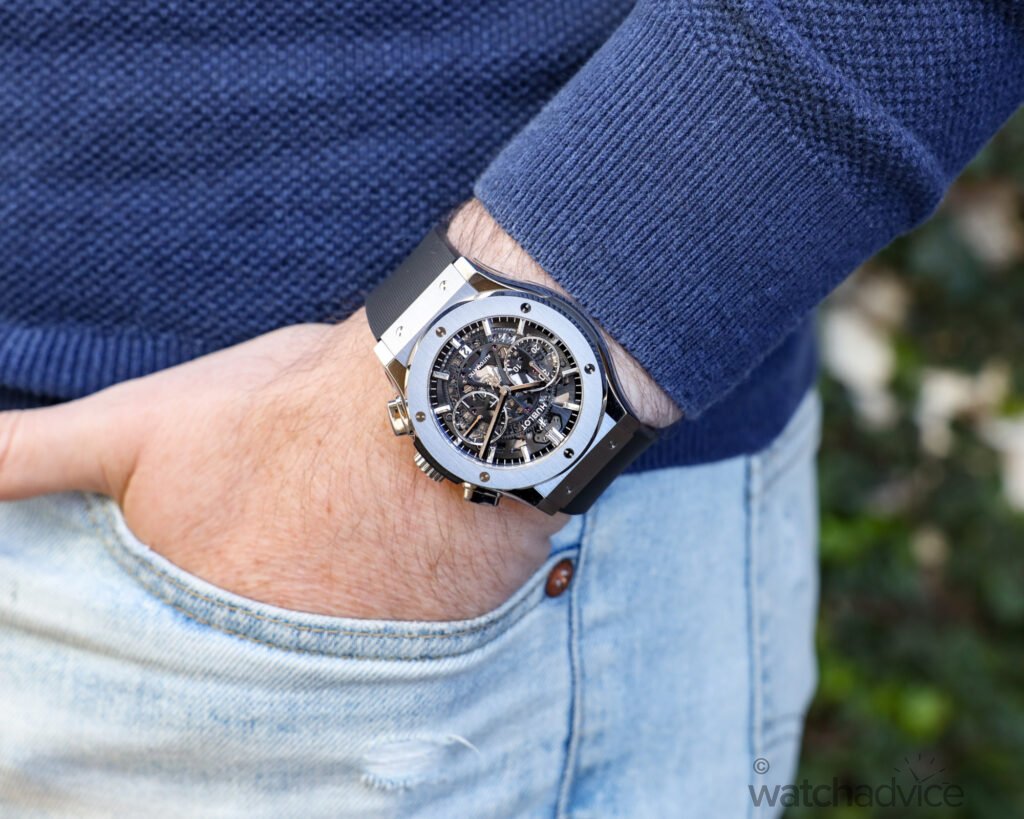The Hublot Aerofusion Titanium Chronograph isn’t your normal sports watch. It’s unapologetically bold, has striking wrist presence and ultimately, fun!
What We Love
- The skeletonised dial looks great
- The look of the polished titanium gives it a lot of wrist presence
- Has the DNA of the original Classic Fusion Original, which is the essence of Hublot
What We Don’t
- The clasp design could worry some wrists
- 45mm will be large for some
- The power reserve is on the smaller side compared to others on the market today
Overall Rating: 8.25/10
- Value for Money: 8/10
- Wearability: 8/10
- Design: 8.5/10
- Build Quality: 8.5/10
It doesn’t get too much more Hublot than the Classic Fusion collection, well, at least from a brand DNA perspective. The Classic Fusion is really where it all kicked off for the brand back in 1980 when Carlo Crocco had the crazy idea of putting rubber and precious metal together on a sports watch. Although it wasn’t called the Classic Fusion back then, that came later under the leadership of Jean Claude-Biver. The design was also something new and daring. Hublot is French for “Porthole” as as such, the design mimiced this with the bezel design and “H” shaped screws that are found on the case. From those beginnings back in 1980, the brand has grown immensely to what we know today. Hublot is a brand that is not afraid of breaking convention, going against the norm, and really just doing it their way!
Over the years, Hublot has evolved substantially and, along the way, has achieved a lot. We’ve seen crazy pieces that turn watchmaking on its head with the MP collection and some very cool collaborations with artists such as Richard Orlinski and Takashi Murakami. But outside of these, we’ve seen Hublot really make strides with their other collections, such as the Big Bang, Meca-10 and Spirit of Big Bang collections. So much so that the Classic Fusion perhaps gets overlooked these days, which is a bit of a shame, as while the pieces don’t get much of the spotlight as other model lines, in essence, the Classic Fusion is what made Hublot, Hublot.
First Impressions
With this in mind, we thought why not review a watch that may not be the first thing that comes to most people‘s mind, at least in the watch world anyway, and get to know the Classic Fusion a bit better. So with the pick of the collection in the Hublot boutique, we settled on possibly one of the coolest Classic Fusion models – the Aerofusion Titanium Chronograph. Why Aerofusion? Because the dial is a Skeleton dial and evokes the feeling of lightness and of coourse, air!
What I love about this watch at first glance is the fact that it has amazing wrist presence when you first put it on. The combination of brushed and polished titanium on the case makes it shine, which makes the watch stand out and catches your eye. The skeletonised dial creates a very different vibe with this watch compared to the other Classic Fusions on the market, but at 45mm, it is not a small watch, and this is something I can’t shy away from in this review. But saying this, when you put it on your wrist, you wouldn’t want it any other way. This is what makes this watch stand out; again, it’s bold in an understated kind of way (compred to the Big Bang that is), which is the modern essence of Hublot.
This isn’t a bad thing either, as Hublot, from the smaller Classic Fusion models for ladies all the way through to their amazing MP creations that go against a lot of the conventions of watchmaking, has pieces that cover the spectrum. And this is one thing that makes them so cool. I’m keen to see how this piece wears over the next few days and the great thing is, I have worn quite a few Hublot pieces now, so I can get a bit of a direct comparison to this versus the others.
The Design
As I mentioned, the Classic Fusion design goes all the way back to 1980 when Carlo Crocco launched the very first Hublot watch. It is a design that stands out, and there is no other watch brand on the market that looks like a Hublot. I mean, who else would think of taking a boat porthole and using it as the design inspriation for a watch, let alone the actual name? However, this is a good thing because there are now many brands that offer either bland and boring designs or, in the case of some micro-brands or independent brands, take design cues from more well-known, established brands. Now there is nothing wrong with this, but creativity and innovation is something I feel lacks in the watch world possibly more often than it should, which is why when we head to Watches & Wonders each year, it’s great to see the brands that are innovating with either new designs or completely rewriting how they work in existing case designs and shapes.
Hublot is one brand that does this well, as I’ve discussed previously with the likes of Ricardo Guadalupe, and more recently at this year’s Watches & Wonders, Julien Tornare (interview to come) – Hublot is a brand that doesn’t have hundreds of years of heritage which can be constraining, instead they are free to go their own way and create watches for people who want something outside of the convention, and something fun they can add to their collections once they have those tried and true pieces.
I won’t delve too much into the case design much as plenty of others have covered this over the years. The Classic Fusion has been around now since 2004 in it’s current iteration, harkening back to the orginal Hublot design from the ’80s, but this piece, the Aerofusion Titanium Chronograph, is a little bit different. Firstly, it is titanium for a start, and secondly, they have skeletonised the dial to give this a more sporty look – and it really does stand out.
The combination of brushed titanium on the top of the bezel, as well as the centre section of the case where the strap joins between the lugs really contrasts with the rest of the case, which is all high polish. The other aspect about the Aerofusion Titanium is that the sides of the case are actually rounded, so you get less of a blocky feeling on the wrist. The crown and the chronograph pushers are also in high polish, which again, makes this stand out on the wrist.
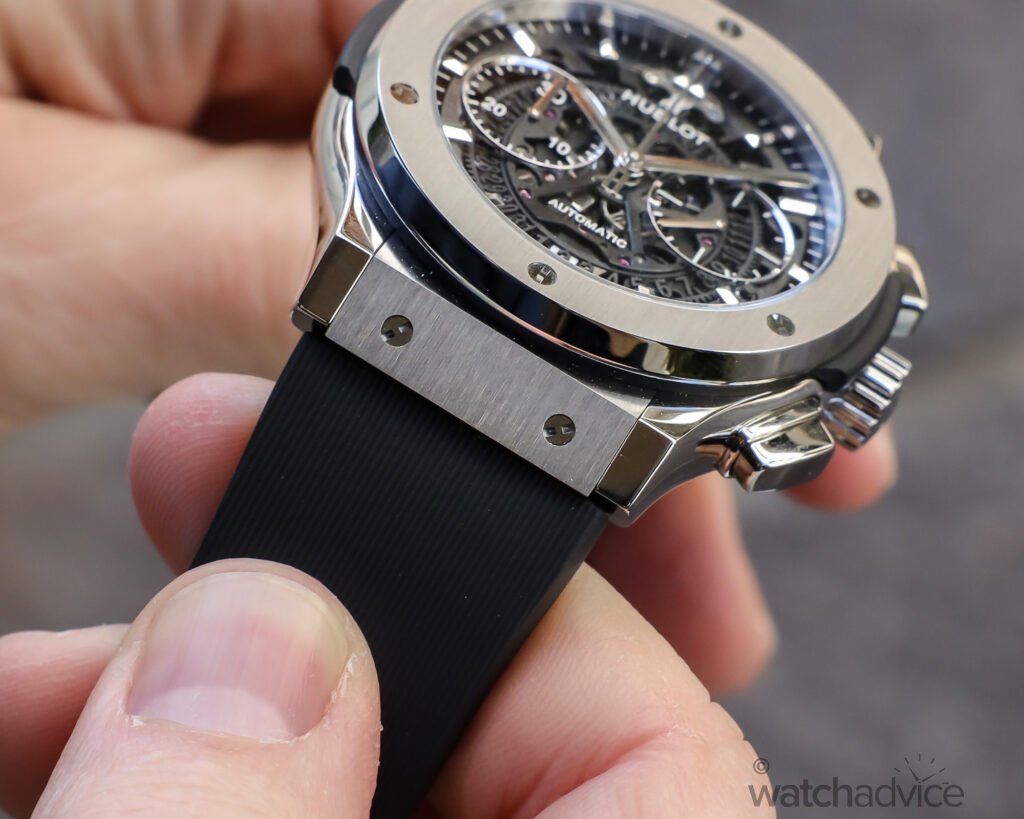
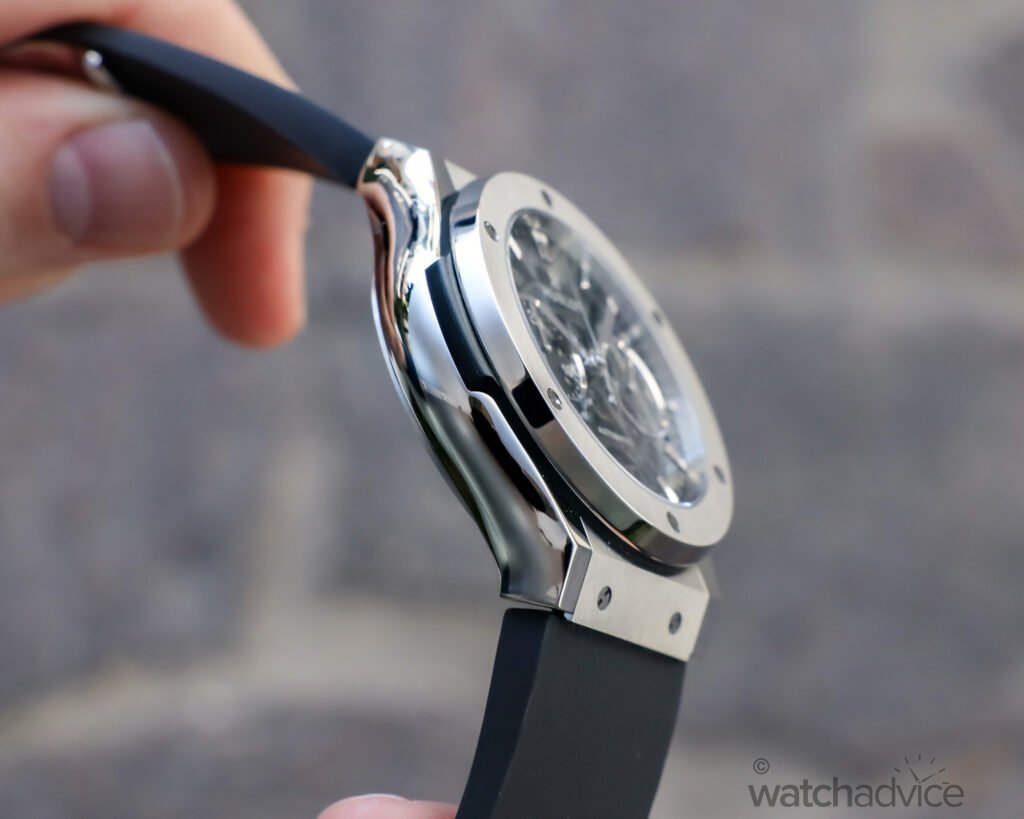
Hublot has kept the separator ring that sits between the bezel and the case, which adds contrast to the piece. Was this a necessary addition? Possibly not. But what it does do is, it breaks up the overall monochromatic look of the case by adding in a touch of black, and complements the black skeletonised dial. Not only this, but it is a central design feature of Classic Fusion and Big Bang watches.
One thing that I will say is the position of the crown is a small detractor from an OCD standpoint. Because of the black separator, the crown doesn’t sit in the middle of the case when you’re looking at it from the side. It sits a lot lower, so for those who like things perfectly lined up in the middle, this may somewhat annoy you. And on that note for those people who don’t love the way, the H screws are in the bezel, I’ll reiterate that these are actual screws that are screwed in from the top down, which is why they don’t all perfectly lineup. This is opposed to other brands out there that use a bolt system where the bolts are dropped in from the top and screwed in from underneath due to the way the case is designed. When it comes to Hublot, this is not the case, and at the end of the day, at least for me, it is not a thing to worry about.
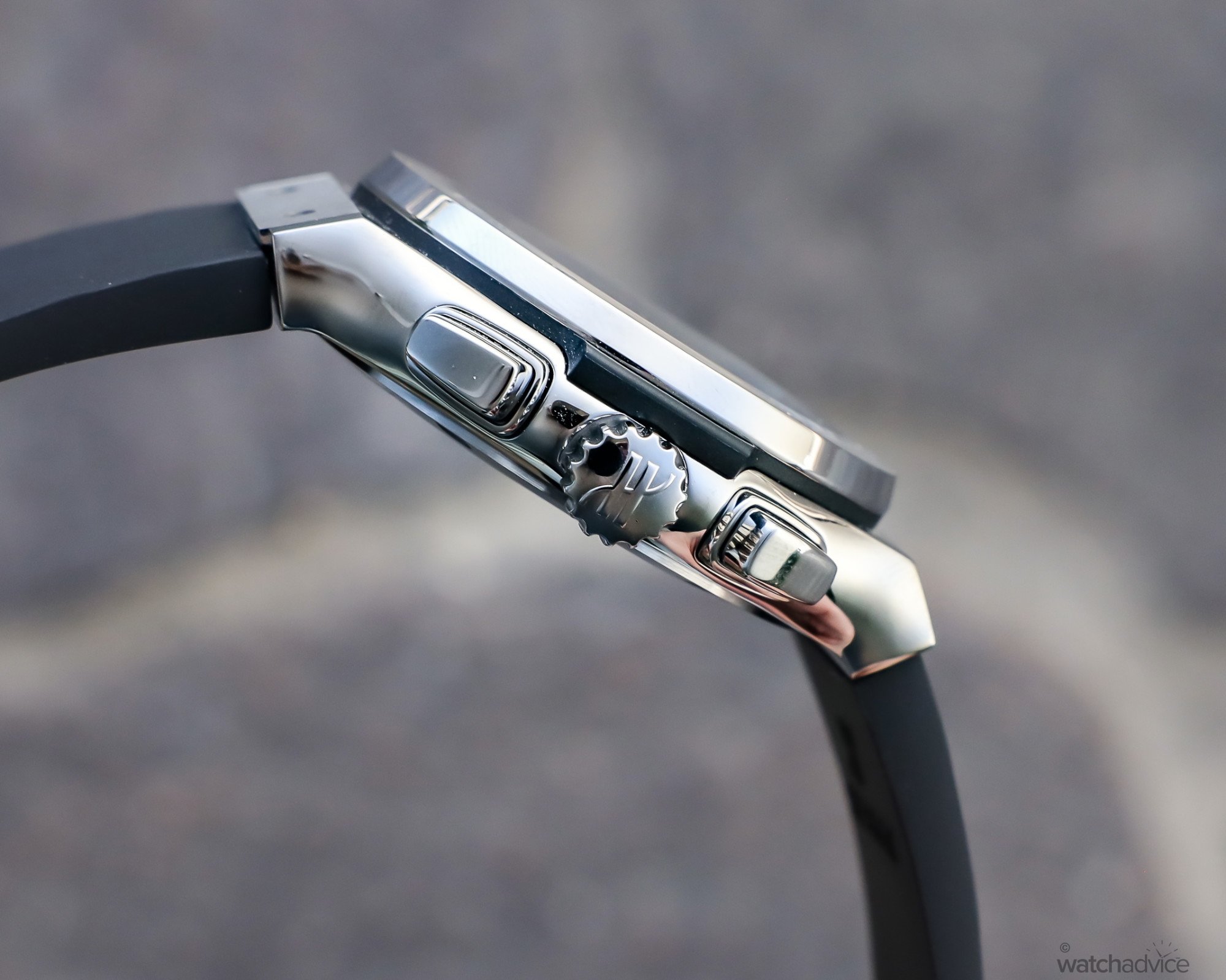
The polished hands and indices on the dial make it easy to read the time against the darkened skeletonised dial during the day, but I will say there is no lume on the watch. So, if you’re planning on taking this piece on any adventures at night, you will be hard pressed to read the time in the dark. But really, this watch is not designed for that; it is designed to be worn in the daylight, so you get the full effect of both the skeletonised dial and the brushed and polished titanium case, which pops on the wrist.
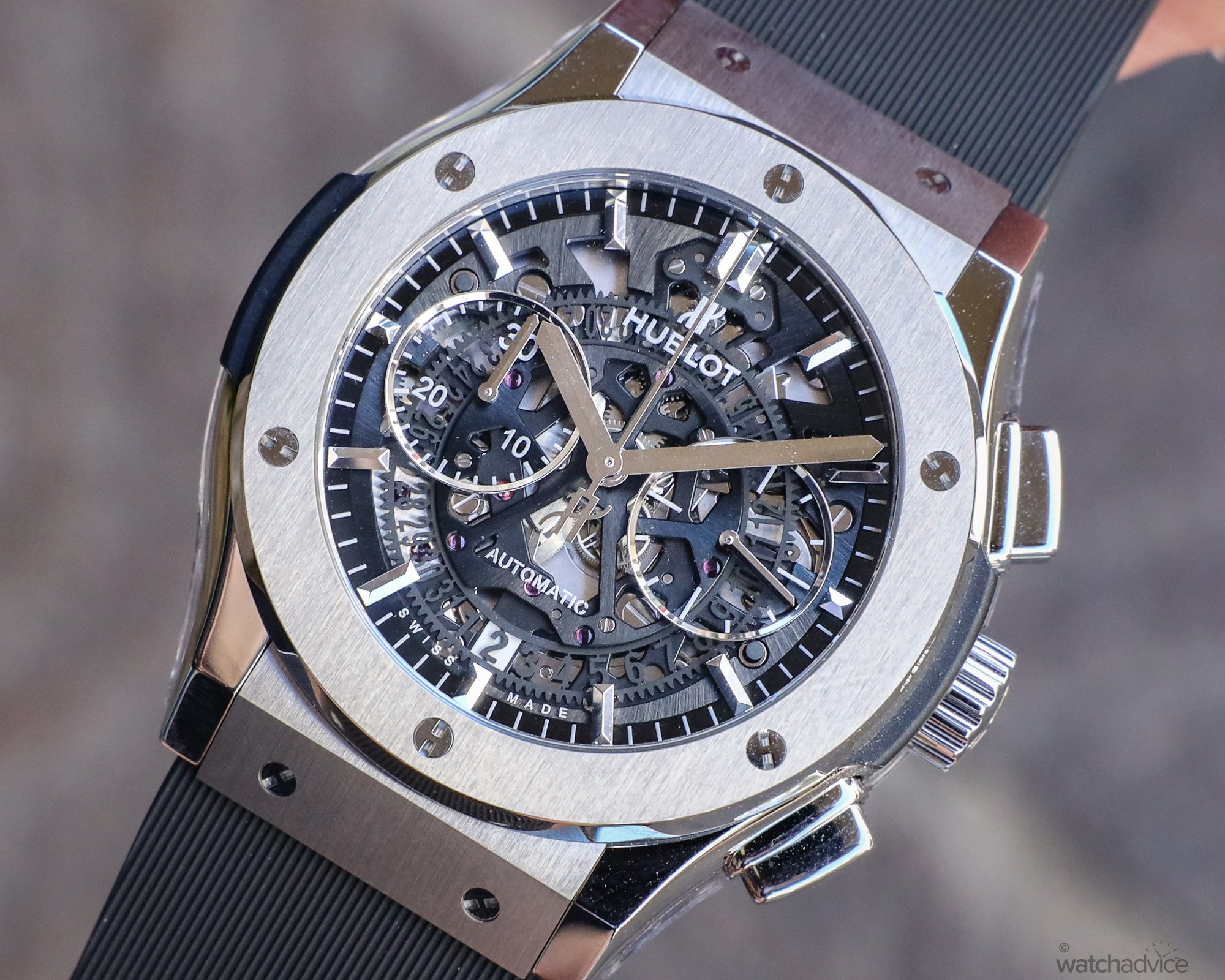
The date wheel on the dial is also skeletonised so you can see through to all the elements of the dial and movement, ensuring the aesthetic isn’t hindered. The small white window at the bottom ensures you can read the actual date at the 6 o’clock position. It is subtle and doesn’t detract from the overall aesthetic of the dial either, so well done to Hublot for that.

The rubber strap is fairly minimalistic, with just fine striations running down the strap, which is more bolstered at the lugs, and thins out towards the clasp, as does the taper. Speaking of the clasp, it is Hublot’s standard push-button folding clasp with the Hublot H in the centre. The outer clasp is brushed as well with Hublot written on it, and two “H” screws for added effect.
How It Wears
As I mentioned in my opening paragraphs, this watch is not a small watch, but it feels good on the wrist and not overly cumbersome, which was actually a surprise to me. Now, if you have smaller wrists than mine, you might find this piece harder to wear, but I have a 17.5cm wrist (avarage for a guy) and I find it doesn’t feel overly large given the specs on paper. Because of the lug design and the bolstered rubber strap, it does flare out slightly on the wrist, which means when you are wearing it, you probably need to wear it on the tighter side so the strap hugs the wrist a little more.
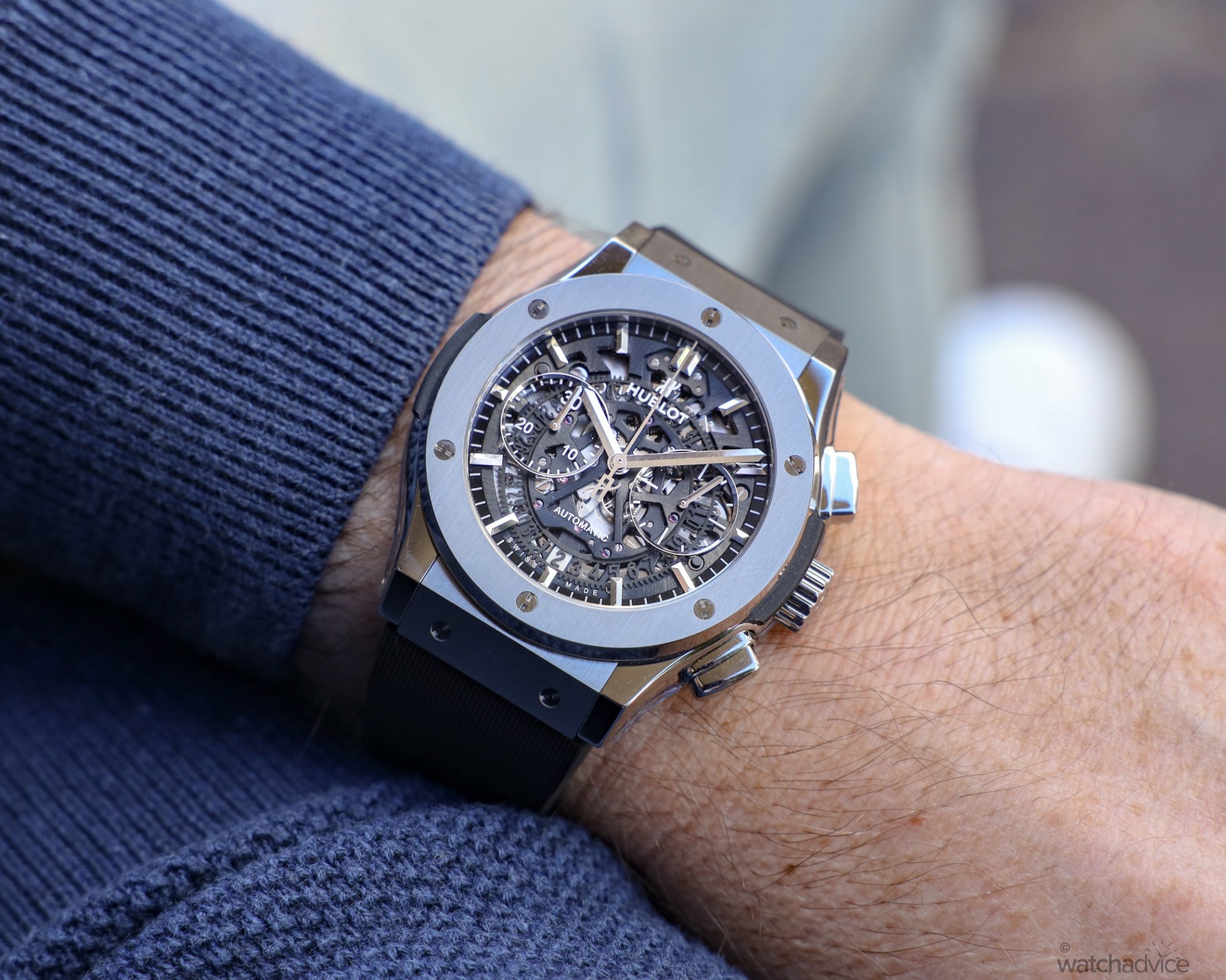
With a thickness of around 15mm and a lug-to-lug of around 54mm, you can see on my wrist it wears flush, and from my perspective in the image above, it does look larger, however, and this is the one thing that I will always advocate – look at the watch on your wrist in the mirror from a few feet away, or have someone take a photo as they see it. You may be surprised. Visual perspective plays a major part when looking at watches on the wrist!
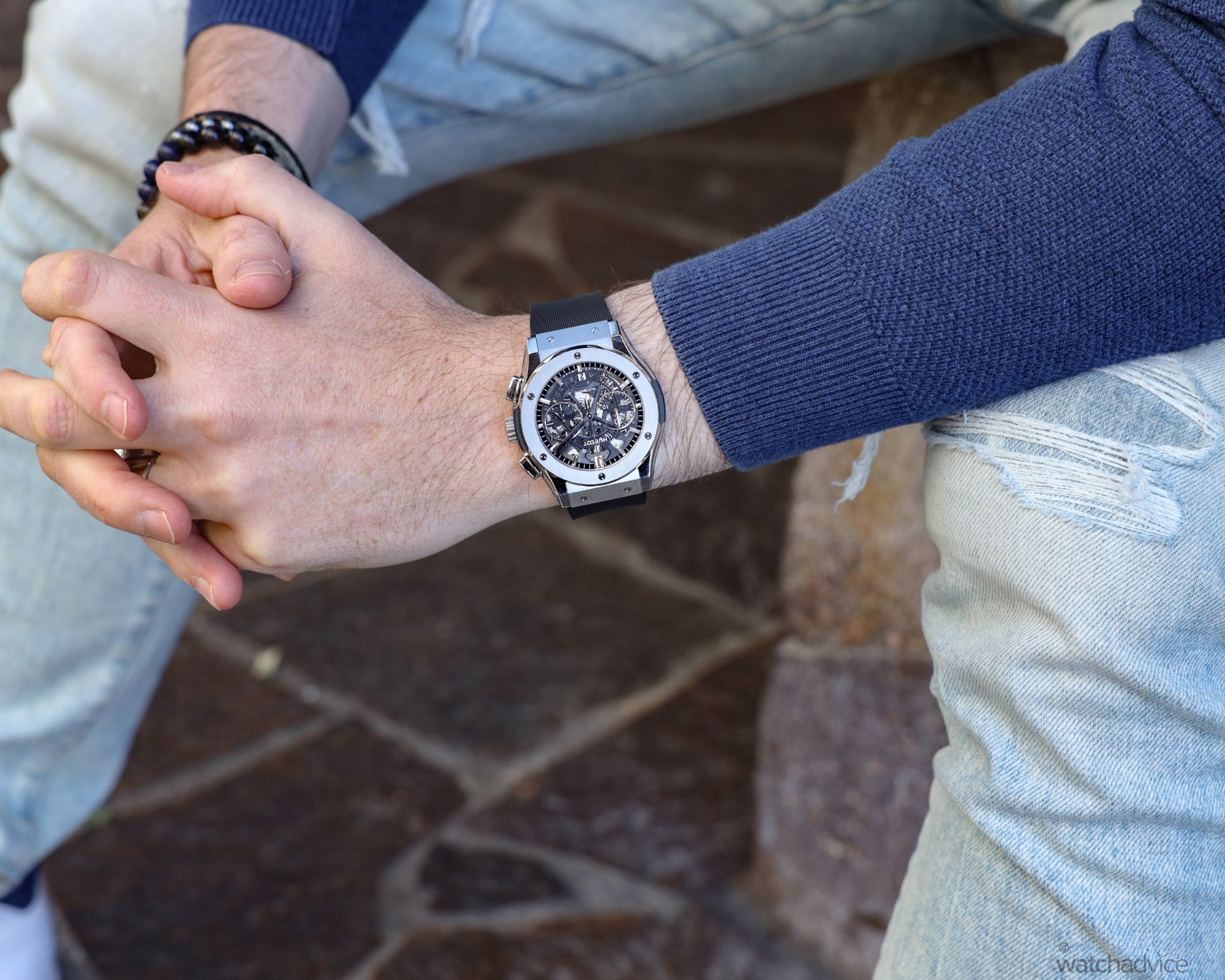
I mentioned in my Hublot Big Bang Meca-10 review last year that the design of the folding clasp did dig into my wrist a little bit, thanks to the inner clasp where the strap slides through under the “H”. This is still the case on the Aerofusion Titanium, but the good news is, on Hublot’s newer Big Bang models, this design has been refined so you don’t get that same feeling on the wrist. I can only imagine it’s a matter of time before the new clasp design finds its way into the other collections outside of the the Big Bang collection.
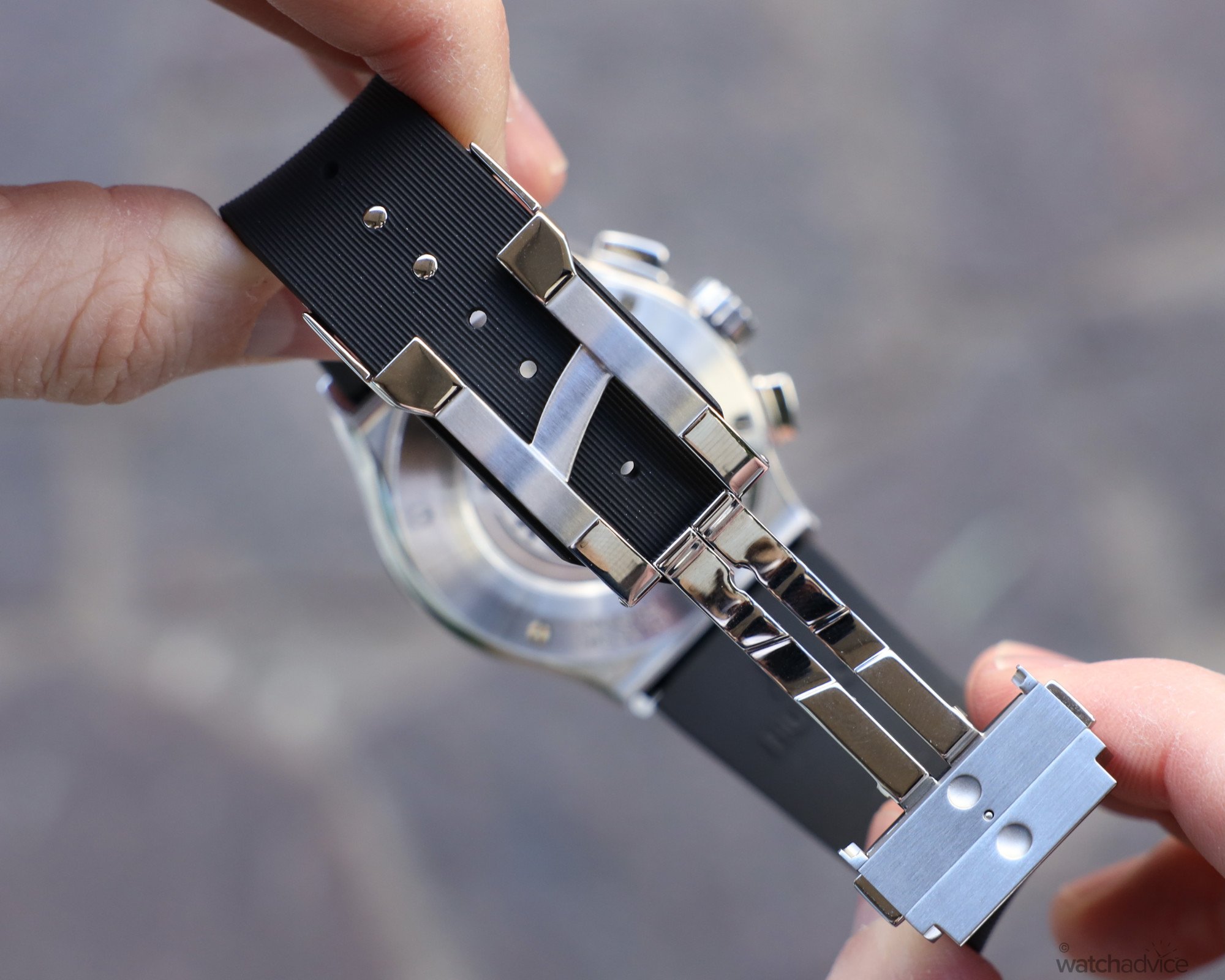
For this piece, I found that rather than making it too tight on the wrist so there is no movement at all, it was at its most comfortable when I gave it just a tiny little bit more space. As the rubber strap contours around the wrist, even with a little bit of give, it doesn’t move around much, and this ensures the comfort on the wrist in both warmer and cooler months, the latter of which we are in now.
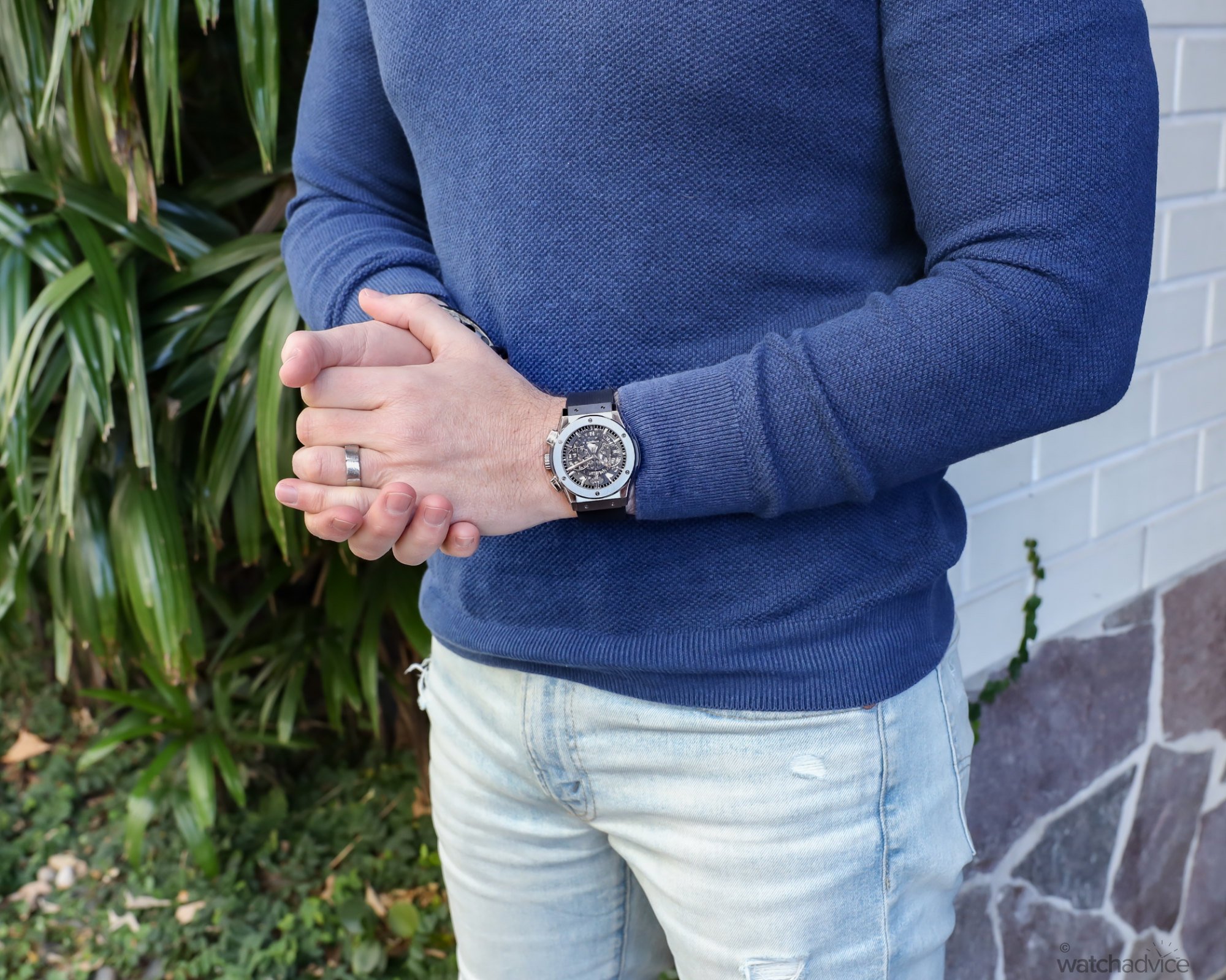
The Movement
Hublot has equipped the Aerofusion Titanium Chronograph with the Calibre HUB1155 Self-winding Skeleton Chronograph Movement. Now, this is not an in-house movement, but based on an ETA2892 that is then modified by Hublot and skeletonised. It isn’t a fully skeletonised movement like you will find in the Classic Fusion Tourbillon Orliski, or the Spirit of Big Bang Tourbillon Carbon, which are more air than metal, but it does show the movement somewhat and amplifies the look of the watch.
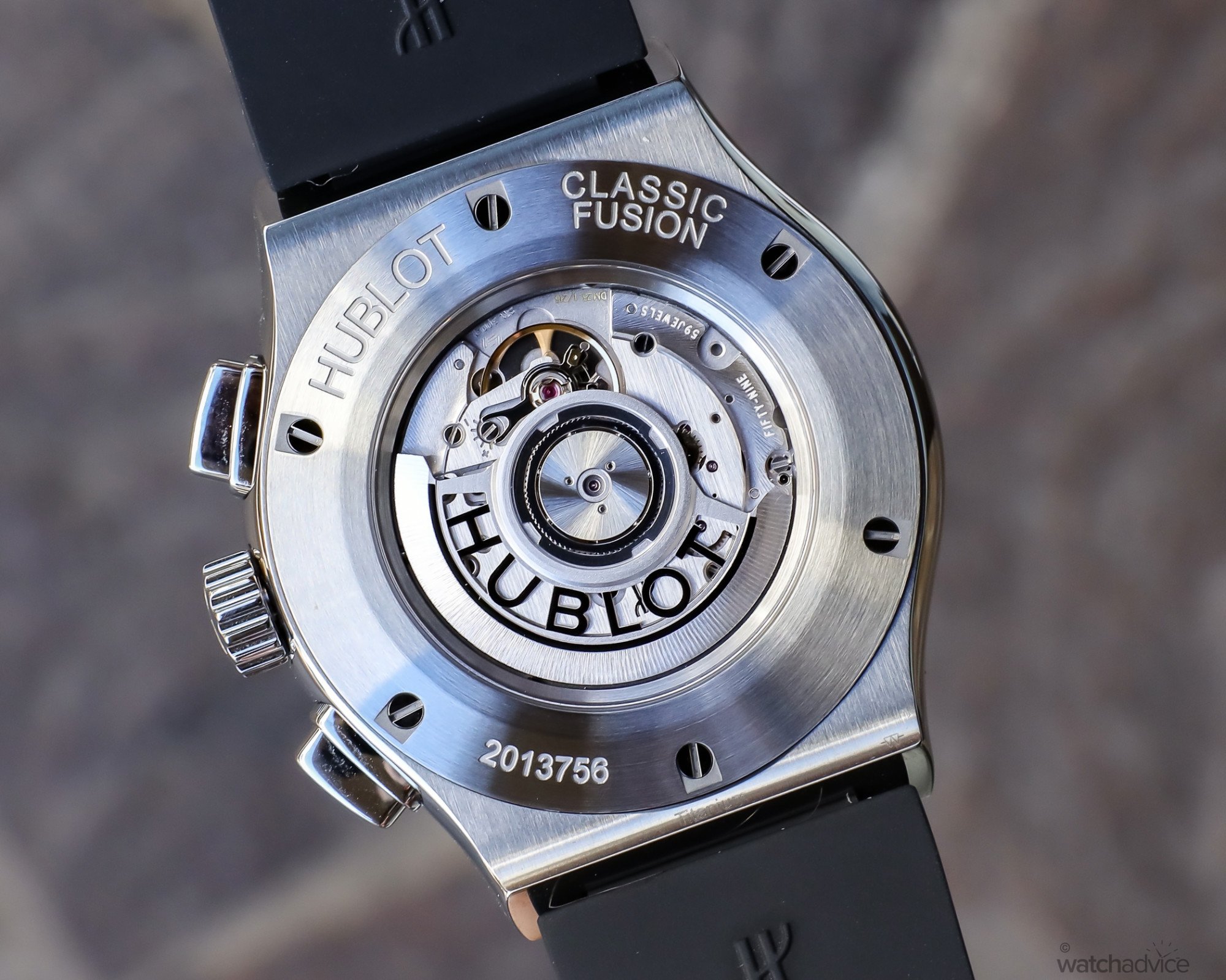
It beats at 4Hz / 28,800VpH and has a 42-hour power reserve. Now these days this is under what the industry average has shifted to, but in saying this, you will most probably see these movements move semi-inhouse in the next few years with movement sharing from sister brands like Zenith or TAG Heuer, or, once Hublot has it’s third building completed and up and running, most probably the Unico will make it’s way into these models. Should this worry you? Not really. The fact that many mainstream brands still use movement bases from ETA or Sellita is still common as it does take substantial capital (and space) to build out a Manufacture with full in-house capabilities – one reason brands that are owned by the likes of LVMH or Richemont do have centralised movement facilities for some of their more entry level brands and models.
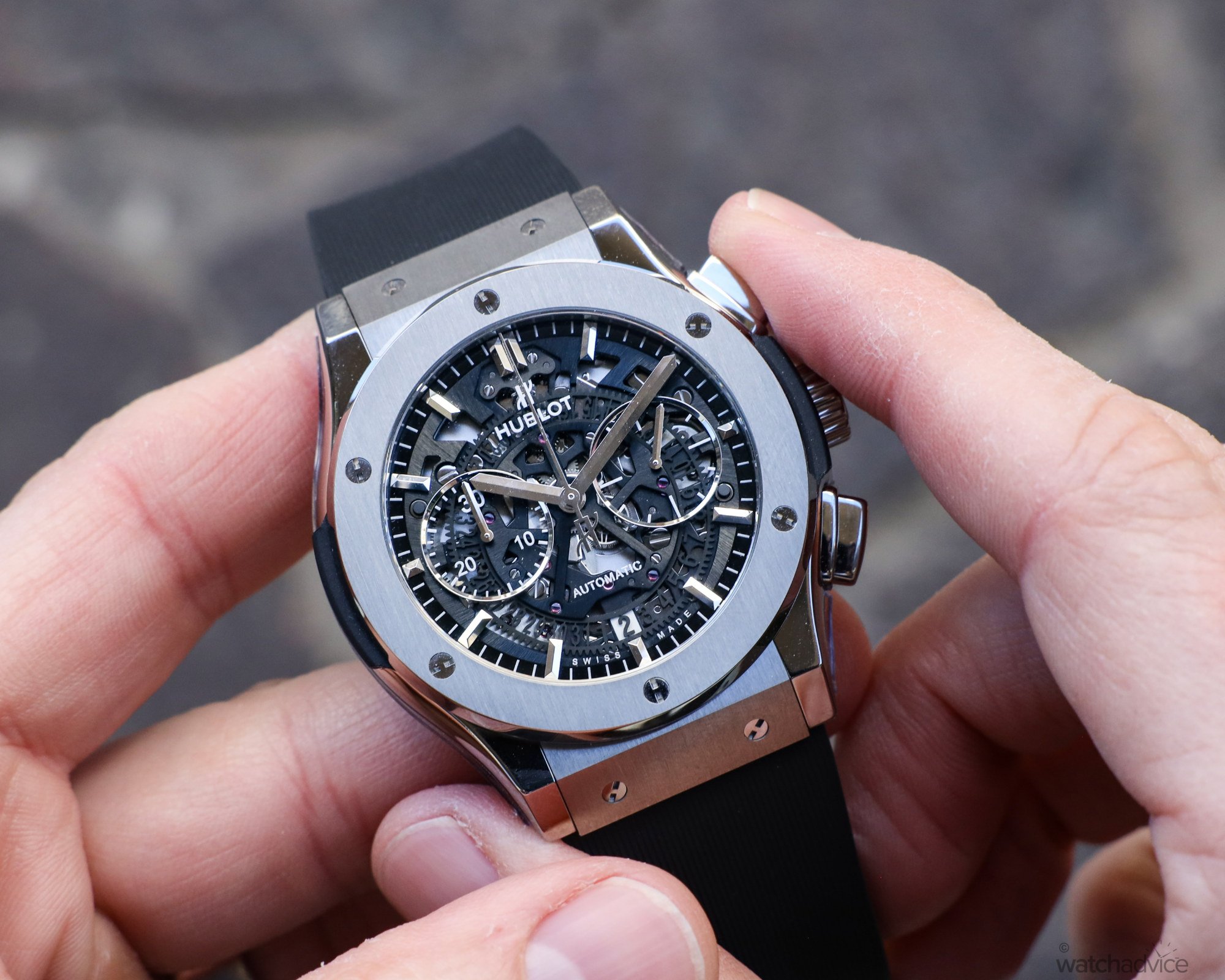
Outside of this, I did the usual tests with the movement, such as testing the chronograph pushers, winding the crown etc. All felt good and within my tolerances – the crown wasn’t overly loose and didn’t have a lot of give when setting the time, the ratchet wheel and gears sounded smooth and not too gritty, and the chronograph start/stop and reset pushers had the standard amount of resistance vs give. Yes, it is very scientific (do you hear the hint of sarcasm here?), but you do get a feel for these things when you have handled and tested out as many pieces as we get to.
Final Thoughts
To be honest, I wasn’t quite sure how the wearing experience of this piece would be. But after wearing it for a majority of the weekend, I have to say I’ve come to enjoy this watch on the wrist as it’s not overly serious. It is fun. Yes, it’s big and yes, it’s bold, but I feel with Hublot that’s kind of the point. And this piece, being 45 mm with a lug to lug of almost 54 mm, it wears surprisingly well, especially if you’re not going to be wearing this watch to the office with a suit for example. And this is not the way I’d want to wear this watch anyway. This is a watch that should be worn casually; it should be worn out and about for people to see, and as the wearer, enjoy the piece for what it is.
The obvious question is, would the Hublot Classic Fusion Aerofusion Titanium be better if it were just slimmed down a little bit to, say, a 42 mm size and slightly thinner? Of course it would, but then you have to ask, would it still have the same wrist presence and be as fun? Now, the answer to that is a little bit subjective, but in my opinion, I don’t think it would be. Maybe that’s just a kid in me talking, but I think that’s also fine, because at the end of the day, sometimes we watch collectors and watching enthusiasts take this hobby of ours a little bit too seriously. We put too much emphasis on heritage in history, and there’s absolutely nothing wrong with that. In fact, that’s part of the magic of it, but on the other side of the coin, it should be fun. It should be based on an out personal taste and not what everybody else thinks, and it should be based around the joy of all watches, big and small, understated and over the top.
And when you think about collecting watches, it’s always good to have a well-rounded collection. This is something that I have learnt more so over recent years as my tastes have changed. If I think about what I liked 5, 6, 7 or more years ago, I gravitated heavily towards dive watches, and I’ll always love dive watches, but in any collection, there is always a place for different styles of watches. As you get a bit older and more mature, you also start to not worry about what other people think and wear what you want to wear, what makes you smile, and your heart sing. A diverse collection that ranges from a small, elegant dress watch to a super fun weekend watch and everything in between is a perfect collection, don’t you think?
And this is where the Hublot Classic Fusion Aerofusion comes into play. It’s the watch that you can wear unashamedly around town, around the house, or out on the weekend with friends and family, and it can bring a smile to your face – which I find is what a lot of Hublot’s do these days when I have a chance to try them on. This, and also, people look at it and ask, “What is that?” It is a conversation starter, and again, in our very insular world of watch collecting, that is great because now you might open up that door to somebody new.
After wearing this piece around for a few days, it’s not the Big Bang Original, it’s not the Big Bang Unico, nor any of their limited edition pieces, but what the Classic Fusion Aerofusion Titanium Chronograph does is, it reminds you of the heritage of Hublot, where the brand began, and where the whole journey started from back in 1980 with Carlo Crocco. For this reason, it is worth considering, if nothing else, or, if you don’t already have something in the collection, it may be the watch that you add to have a piece that is just for your enjoyment and hopefully brings the same smile to your face as it did to me.
Reference: 525.NX.0170.RX
Specifications:
- Case Diameter: 45mm x 15mm thick x 54mm lug-to-lug
- Case Material: Satin-finished and polished titanium
- Bezel: Polished and brushed titanium with 6 H-shaped titanium screws
- Dial: Skeleton dial with silver-tone indices and chronograph sub-dials
- Crystal: Sapphire crystal with anti-reflective treatment
- Caseback: Sapphire crystal
- Movement: HUB1155 self-winding chronograph movement beating at 4Hz / 28,800 VpH
- Power Reserve: Approximately 42 hours
- Water Resistance: 50 metres
- Strap: Black rubber strap with stainless steel push button deployant clasp
Australian Retail Price: A$23,300
Availability: Available from your local Hublot boutique, authorised retailer or online at Hublot.com
Full Image Gallery
